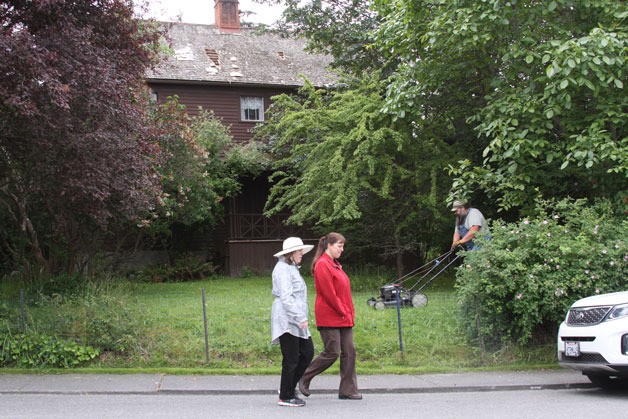As far as Joan McPherson is concerned, nothing detrimental is going to happen to the Haller House.
She’s held a sentimental attachment to the historic Coupeville house long before her family purchased it 10 years ago, and that feeling hasn’t changed.
She called the development last month that ended the four-year efforts by a historic preservation group to acquire the house unfortunate, but not an indicator that the best interests to preserve the house had changed.
“The Haller House has been here for 150 years and it’s going to be here 150 years from now,” McPherson said.
“Our plans have always been to see that it’s taken care of. We’ve had it for over 10 years now. We want to see the right thing done with it.”
IN RECENT years, it appeared that the answer might come from extensive efforts by the nonprofit group, Historic Whidbey, to acquire the 1866 house, restore it and transform it into the state’s first territorial heritage center.
The group appeared to be on its way to receiving a significant heritage capital projects grant from the Washington State Historical Society, but a critical issue emerged during the grant screening process that derailed the project’s eligibility.
The issue centered around the timing of the home sale, which was set to be completed by Aug. 31 under a purchase agreement between the McPhersons and Historic Whidbey.
The state historical society informed Historic Whidbey that each grant project first needed legislative approval and eligibility required that the purchase of the Haller House not be finalized until after the next legislative session in the spring.
Historic Whidbey and the McPhersons were unable to negotiate an extension to the purchase agreement that met the satisfaction of both parties, according to Lynn Hyde, president of Historic Whidbey.
An advisory panel with the state historical society had ranked the Haller House project No. 29 out of 44 submitted applications but it lost its eligibility for funding when the purchase agreement couldn’t be extended.
In the end, 35 projects were recommended for funding in the next legislative session.
“WE’RE ALL in mourning now,” Hyde said. “It’s like a death for all of us, especially because we were so certain we had that grant.”
Hyde had dreamed that the house, once the home of controversial Civil War Army Major Granville Haller and his wife, would be the ideal site for a heritage and visitor center to showcase Washington’s territorial period from the 1850s through the 1870s.
When an anonymous Seattle donor pledged in April to give $50,000 toward the effort if others would match that amount, it kick-started a fundraising campaign that was trying to raise enough money to make the house eligible for the state heritage capital projects grant, which would pitch in one-third of the purchase price.
The McPhersons agreed to lower the price of the house to help make that happen, but in the end, the parties couldn’t agree on the final details of an extension last month.
“I don’t know what’s going to happen now. It’s still pretty fresh,” said Sarah Steen, preservation coordinator of Ebey’s Landing National Historical Reserve.
“It is of major concern to us. It’s one of the most important territorial buildings here and we certainly will be watching.”
Historic Whidbey began its pursuit to acquire the house when it was put up for sale in 2012.
Since then, the group signed a lease to allow time to raise donations in hopes of acquiring the historic home.
THE HOUSE is located at the corner of Front and North Main streets, just across the road from the historic building in which Joan McPherson lives and the McPherson & McPherson law firm is located.
“It’s not just a historic building, it’s across the street,” said McPherson, who’s lived in Coupeville for more than 40 years and is a former Island County Superior Court judge.
“We want to see it taken care of,” she said. “We want to see the right thing done whatever that turns out to be.
“We don’t have any specific plans now. We thought Historic Whidbey’s plans were to buy it.
“This is all rather sudden.”
THE HOUSE is one of 30 surviving “early settlement era” structures (1850s to 1870s) out of more than 400 historic buildings within the reserve listed on the National Register of Historic Places, Steen said.
It was once considered the site of a visitor’s center for the reserve, but that plan failed, too.
Although the house needs major interior work and lacks modern-day amenities, McPherson said there is no thought of attempting to demolish it and starting anew.
“That’s not even a possibility,” she said. “I’d be out there in front of the bulldozer if something tried to tear it down.”
Should the home go back on the market, Steen said the reserve would work with Realtors and potential buyers to try to maintain the integrity of the house as much as possible.
And should a new buyer want to demolish the historic house in the historic reserve?
“It’s a difficult process and it’s made that way on purpose,” said Steen, adding that many incentives are offered instead to try to discourage such attempts.
“It’s not impossible. It’s engineered to be difficult because of the historic nature of the reserve and the impact of the buildings here.”



